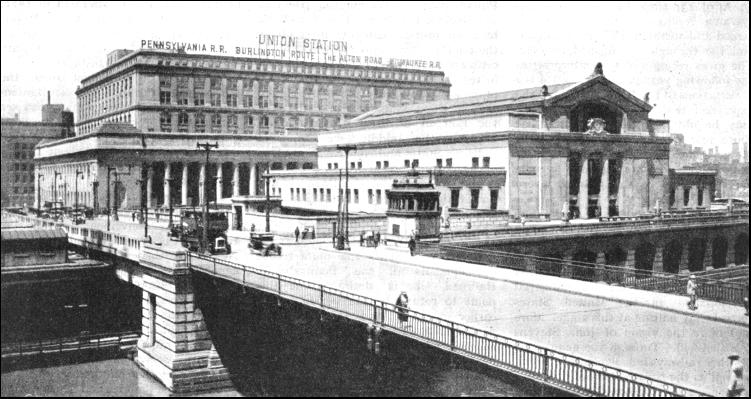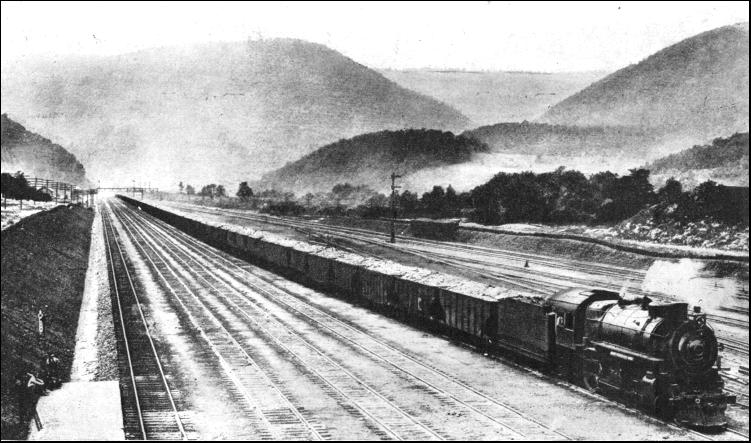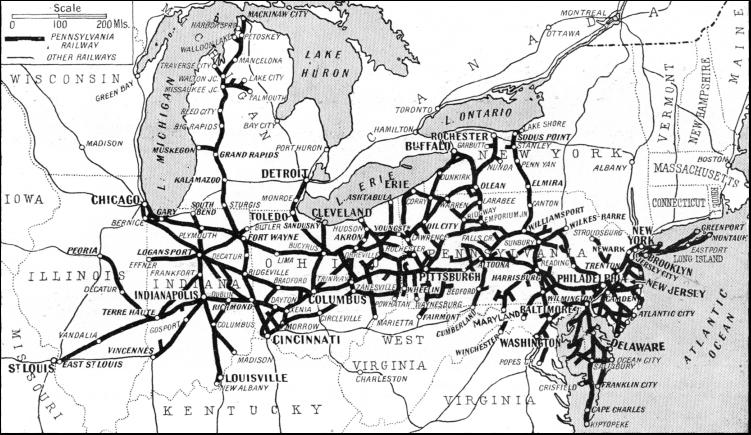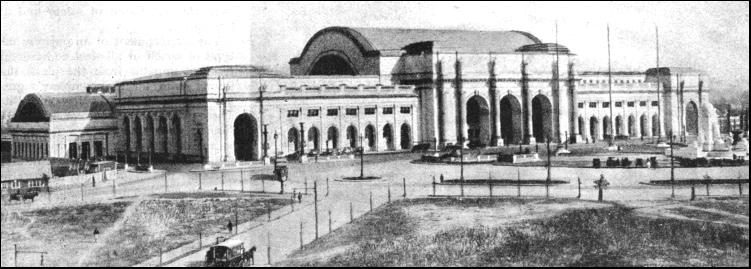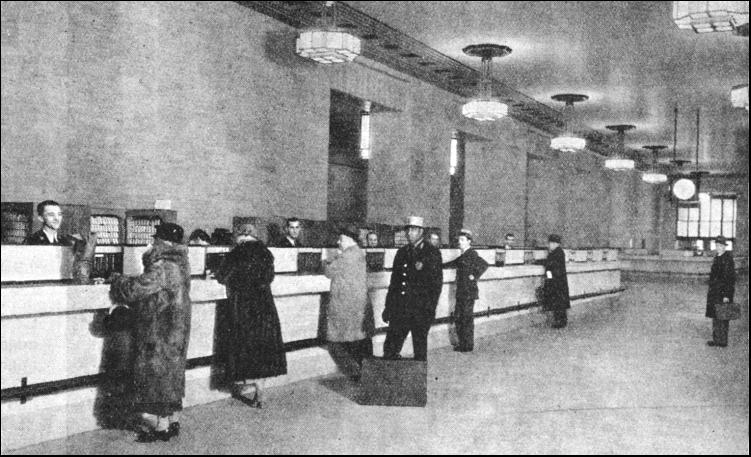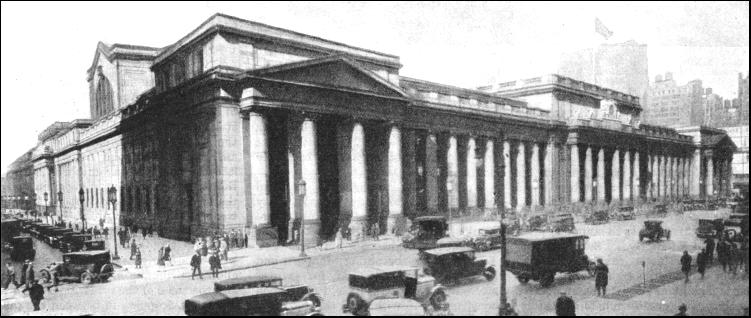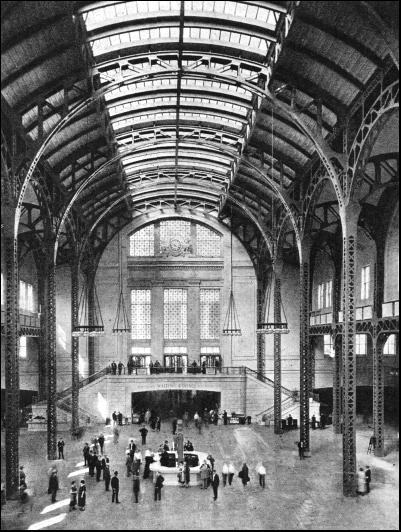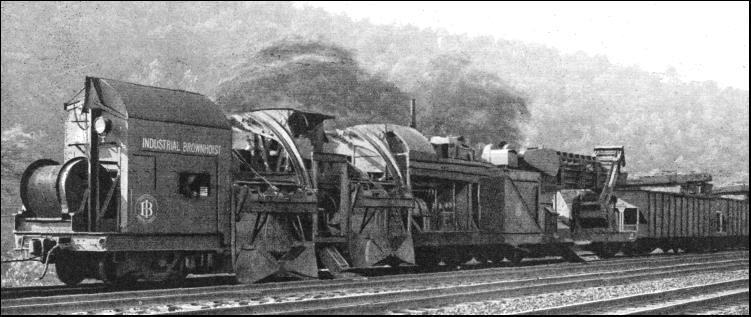|
|
THE Pennsylvania Railroad claims to handle a greater volume of traffic, measured in tons of freight and passengers carried per mile, than any other transportation system. It has in hand one of the largest railway electrification projects and owns and operates the largest private telephone and telegraph plant in the world. The territory which it covers comprises the great central belt of the United States, extending from the Great Lakes and the Canadian border into the Southern States, and from the Mississippi River to the Atlantic seaboard. This is by far the most intensively developed area of its size in America. Within its limits, it includes approximately fifty per cent of the entire population of the United States, and a much larger proportion of the country's industrial, commercial, and mining enterprises. The railroad owns and operates some 12,000 miles of road and 30,000 miles of track, its lines traversing the District of Columbia and thirteen States—New York, New Jersey, Pennsylvania, Delaware, Maryland, Virginia, West Virginia, Ohio, Indiana, Michigan, Illinois, Kentucky, and Missouri. The development of the Pennsylvania Railroad, from small beginnings early in the nineteenth century to its present noteworthy scale of equipment and operation, is remarkable. The origins of this system are referred to on the page "America's First Trains." It is noted on that page that a project of John Stevens—widely known as the father of American railways—to build a steam-operated line was rejected by the New York Legislature as. early as 1812. Undaunted, Stevens persevered with his schemes, and in 1815 obtained the first charter ever granted in the United States for building a railway. Although that particular project lapsed, Stevens obtained another charter from the Pennsylvania Legislature in 1823 for the construction of a line from Philadelphia to Columbia (Pa.), a distance of about eighty miles. But by that time the vision of this courageous pioneer had ranged far beyond the limits assigned for this enterprise, and he had in view an extension of the line from Philadelphia across New Jersey to the city of New York.
Passengers were at first conveyed from one city to the other by a combined system of railroads and canals. Early in the 'thirties the railway from Philadelphia was extended as tar as Harrisburg (Pa.). The rapidly increasing requirements for improved transport facilities soon led to a demand for a continuous rail line between Philadelphia and Pittsburgh, linking the two principal cities of the State and providing Philadelphia with a direct link with navigation on the Ohio River, the leading highway into the New West. Here we come to the birth of the Pennsylvania Railroad of to-day. It was to bring about the materialization of this continuous line across the State that the company received its charter on April 13, 1846, the original Pennsylvania Railroad having been State-owned and operated. Work was begun, and the through line opened in 1852. The gross receipts of the enterprise in the following year greatly exceeded the expectations of the time An idea of the expansion that has since taken place may be obtained from the fact that those receipts for one year represent now, under modern conditions of peak traffic, no more than the average gross earnings of the railroad every thirty-one hours. The main objectives of the promoters—to link Philadelphia with the New West, and to safeguard the trade interests of the city against competition from neighbouring ports—had now been achieved. But the trend of industrial development in the United States forbade any halting at this stage. More and more the vision of John Stevens was justified. Through the acquisition of other railways independently started, as well as the construction of new tines when necessary, the system was extended until, during the period following the close of the Civil War, the main skeleton of the Pennsylvania Railroad had grown to something of its present outline. During the 'eighties the company's lines were extended from Philadelphia and Wilmington (Del.) to the Norfolk gateway The New York terminal project, carrying lines under the Hudson River into and through the centre of New York City, was completed in 1910. The Hell Gate Bridge route. in combination with the New Haven system, when completed in 1916, gave the railroad a direct through route between the middle, western, and southern States and New England. One of the most important of later extensions is the linking up of the Pennsylvania lines with the city of Detroit. This was completed in 1923. Before we discuss the more recent developments of the Pennsylvania Railroad, it is desirable at this point to return to the period of its earlier progress, and to record the development of an interesting pioneer railway destined in due course to become part of the Pennsylvania system.
In 1831 the Camden and Amboy Railroad, the first line to be laid in the State of New Jersey, was built first between Bordentown and South Amboy and later extended from Bordentown to Camden, a total distance of sixty-two miles. The Pennsylvania took over the Camden and Amboy Railroad in 1871, and all records of early railroad construction agree that this ancient stretch of track was one of the first to be laid anywhere in the United States. Passengers, who travel over the Pennsylvania Railroad between Bordentown, N.J., and South Amboy can see this length of old railway, laid on large granite blocks, just beside the tracks near Jamesburg Station, about twenty miles north-east of Trenton, the State capital. It was in the late spring of 1831 that pioneers, in search of a quicker and more convenient means of transport between Philadelphia and New York than the stage coach and canal boat, laid the old track as part of the original Camden and South Amboy line. Despite the fact that it has been exposed to the elements tor a full century, this relic of the infancy of America's railway system is in a fair state ot preservation, and gives, promise of lasting another hundred years. The pioneer Camden and South Amboy Railroad was chartered by the New Jersey State Legislature late in 1830 to operate a combined rail and water route between Philadelphia, Camden, and New York City. No iron suitable for the tracks was available in the United States, and the railroad's first president, Robert L. Stevens, sailed for England to develop with London iron workers a satisfactory rail design. Whiling away idle hours on board ship, Stevens worked out an entirely new type of rail for his line, marking a distinct departure from the type then in use in England, and on the one or two short stretches of railway already operating in the United States. He discarded the old wooden rail or stone stringer plated with scrap iron then in general use, and designed a crude but practical anticipation of the T-rail which, with slight variations in shape and modernization in size and weight, is still the standard design of railway tracks to-day. This rail was used by Robert Stevens for the first time on the old Camden and South Amboy Railroad. The first lengths of rail for the pioneer line were received by ship from England early in 1831, and the first piece of track, five-sixths of a mile long, was laid during the summer of that year from Bordentown northwards, in the direction of Hightstown. Later, the line was extended to Hightstown and thence to South Amboy, reaching completion late in 1832.
Part of this original iron track, designed by Robert Stevens, may be seen to-day at Jamesburg. The track was laid on great stone blocks two feet square bought from the prison authorities at Sing Sing, New York. The rail was attached to the stones by a newly devised hook-headed spike, the forerunner of the spike now in general use. The rail weighed 40 lb. to the yard as compared with 132 and 152 lb. rail weights on the Pennsylvania Railroad to-day, and was rolled in lengths of 16 feet. The ends of the rails rested on wrought iron plates and were connected by iron tongues five inches long, which were riveted to the rail ends, completing the joint. Although the first cars were pulled by horses, this pioneer line was one of the first in the country to use a steam locomotive. The engine "John Bull," built in England, carried the first passengers by steam in the State of New Jersey over the Camden and Amboy, a short distance out of Bordentown, on November 12, 1831. A large party braved the uncertainties of the new means of transport, including many members of the New Jersey Legislature, prominent business men, and others. During the first few years of its operation passengers over this route were carried in steamboats between Philadelphia and Bordentown, and between South Amboy and New York. With the completion of the line early in 1834, however, the through rail route across New Jersey was opened. When this early railroad to South Amboy was built, iron rails were spiked directly to wooden sleepers for the first time in railway history. A deep cutting was made near the town for the projected line, and—the authorities at Sing Sing having failed to deliver stone blocks rapidly enough—the engineers in charge ordered hewn wood sleepers to be laid temporarily, the rail being spiked directly to the sleepers. A number of these sleepers were put down on the sharpest curves of the cutting.
To the surprise of all they gave such satisfactory service, and were so well suited to the purpose, that they were allowed to remain. As time went on, and experience taught its many lessons, the stone blocks in the track were gradually removed and replaced by the wooden sleepers. This track was undoubtedly one of the first to be laid with rails secured direct to wooden cross ties, a practice which has since been widely adopted throughout the world. It is not possible here to give historical details of other early railways now forming part of the Pennsylvania Railroad, the lines of which originally embraced over 600 distinct corporations. It is desirable, however, to note the trend of Pennsylvania locomotive development since the days of the "John Bull" referred to above. This locomotive—still in existence—comprises a miniature engine and boiler with a tall chimney, mounted on four small driving wheels, and having a long, protruding "leading truck" and a curious tank-like firebox. The weight is eleven tons. In 1893, sixty-two years after it was built, the locomotive left New York under its own steam and hauled a "train" consisting of two small trucks. It reached Chicago, 912 miles away, in five days without mishap. This early locomotive embodied three basic principles of design—the use of exhaust steam for forced draught, a boiler arranged to produce much steam in a small space, and horizontal cylinders to drive the wheels. And as the sixty-two years old "John Bull" puffed along to Chicago, the "Pennsylvania Limited"—then one of the most famous trains in the world—sped past it at thirty-five miles an hour, using these same basic principles for an enormously greater production of power. In the early days, more power was largely a question of greater speed. But soon the important consideration became rather a question of how much work a locomotive could do, and not merely the speed at which it could do it. An engine in service a little later than "John Bull" drew thirteen tons of freight at a maximum speed of twenty-nine miles an hour on a level track. To-day Pennsylvania freight locomotives can draw one hundred steel wagons, containing 7,000 tons of coal, on varied grades and at higher speeds. At first, however, ordinary speeds left much to be desired. By 1856 the fastest of three daily express trains from Philadelphia to Pittsburgh had a regular schedule of just over twenty-five miles an hour. This was the average speed of the best passenger trains for some years afterwards. But about that time the Pennsylvania built its great engine works at Altoona, not many miles from the famous Horseshoe Curve, and the design and construction of locomotives entered on a new phase.
Hitherto the engines had been equipped with huge chimneys, the top diameter of which was larger than that of the boiler or the driving wheels. This was because wood fuel was used. In the 'fifties a series of experiments carried out at Altoona demonstrated the practicability of bituminous coal as a fuel, and the brick arch was also introduced. "More power" now came to mean fuel economy, reliability, labour saving, and ability to haul bigger loads, as well as maintaining higher speeds combined with safety, under varying conditions. The Pennsylvania Railroad introduced steel fireboxes in 1861 ; and in 1868 steel boiler sheets and steel tubes were used in the new locomotives. But looking back to those years of rapid progress the greatest achievement of all was, perhaps, the introduction of the air-brake, first used by this railroad. In 1870, after extensive experiment, the airbrake was made standard, and when the automatic feature of the Westinghouse brake was developed, this also was adopted, being made standard practice over the whole system in 1878. Without the automatic air-brake, the powerful locomotives of the present day would never have been built. Tractive force of 45,000 pounds in a passenger locomotive would be useless, for great power cannot be used unless it can be adequately controlled. There would be no "Broadway Limited" travelling quietly and easily at an average speed of fifty-three miles an hour, if the driver could not stop the train swiftly, surely, and safely, with a movement of his hand. Nor would there be freight locomotives weighing 180 tons hauling trains of a hundred fully loaded steel trucks at twenty-five miles an hour, if means had not been provided for completely controlling the great power of the modern locomotive engine.
Meanwhile, traffic demands increased steadily from year to year. In 1887 a new "flyer" was perfected. It drew passenger trains between New York and Philadelphia at almost the schedule of to-day. Since then, until the extensive accelerations of 1935 the normal speed of passenger trains did not greatly increase. In 1912 still further progress was made by incorporating superheaters as standard practice for all locomotives. Such developments made faster running possible ; but in general the trend has been towards a combination of greater tractive capacity with greater reliability, safety, and economy, rather than attempts to achieve record-breaking speeds. A notable development necessitating more powerful locomotives was the adoption of all-steel rolling-stock. With this innovation widely adopted, the weight of every train was approximately doubled. In 1902 the Pennsylvania Railroad began actively to study the possibility of building a stronger, safer, and more comfortable passenger coach than the wooden coach then in universal use. Trains were becoming longer and heavier ; there was need for greater strength and more durability in coach construction to withstand the wear and tear of daily service. While the introduction of the steel underframe met this condition to some extent, the wooden coach body still remained a problem from the standpoint of safety and fire prevention. The development of an entirely new type of coach of all-steel construction received impetus from the plans then taking form for the company's great new terminal project in New York City. These plans involved the construction of tunnels under the Hudson River, as a means of providing access to the proposed new station in the heart of Manhattan. The undesirability of operating wooden coaches through such tunnels was obvious ; this supplied an additional incentive for evolving the design of an entirely new type of coach, free from the objections inherent in the old form of wooden coach construction. All of these influences worked together, and .in 1906 the first steel passenger coach was turned out at the Altoona Works. In the same year the steel coach was made standard for the whole system, and the building of wooden coaches discontinued. By 1914 more than a third of the Pennsylvania's passenger equipment was of all-steel construction. To-day this equipment is practically one hundred per cent steel. It is not generally known in other countries that American rail transport as a whole was greatly hampered in its progress by the variety of gauges adopted. The first roads built in the eastern States conformed to the British gauge of 4 ft. 8-1/2 in. Later, however, gauges were adopted ranging from 3 ft. to 6 ft. The States of New Jersey and Ohio established by law a gauge of 4 ft. 10 in. ; 5 ft. was fixed as the gauge of South Carolina Railroad, and was also adopted by a number of other roads in the South ; 5-1/2 ft. was established for Missouri and Canadian roads ; and 6 ft. as that of the New York and Erie and the Atlantic and Great Western.
By 1880 the northern lines had in general come to a uniform standard of 4 ft. 8-1/2 in., or an interchangeable standard of 4 ft. 9 in., which facilitated the convenient interchange of coaches and traffic. Sir John Aspinall a well-known British railway authority, records that when in America in 1872 he noted that freight cars were labelled "broad tread" and "narrow tread." When he asked the reason for this, he was told that the treads of the wheel flanges were sufficiently near to one another to allow safe running on a 4 ft. 8-1/2 in. gauge, and the tread of the tyre wide enough to prevent it dropping in between the rails on a wide track of 4 ft. 10 in. In 1892 the Pennsylvania Railroad adopted a 4 ft. 8-1/2 in. gauge as standard for passenger tracks, and 4 ft. 9 in. for freight tracks. The present gauge for all Pennsylvania tracks is 4 ft. 8-1/2 in. Another important development, and one which has greatly influenced the speed of trains, is the use of water troughs on the permanent way, enabling locomotives to take in a supply of water while in motion. This idea is due to John Ramsbottom, Locomotive Superintendent of the London and North Western Railway from 1857 to 1871. In 1860 the first water troughs on record were laid on the Chester-Holyhead line of the London and North Western Railway. The idea appealed to American railwaymen, and Ramsbottom troughs appeared on the Pennsylvania Railroad at an early date. In Great Britain, however, no other railway made use of water troughs until 1886, when they were installed on the Lancashire and Yorkshire Railway.
In view of the much-discussed problem of electrifying British railways, it is of great interest to note the development of railway electrification in the United States. The first project of this type to be completed and opened was the electric operation of traffic through the tunnel at Baltimore in 1895. In the same year, the Pennsylvania Railroad opened a short electrified line between Mount Holly and Burlington, N.J., while the New Haven system began to operate its Nantasket Beach electric line, in Massachusetts. The first large-scale electrification project in the United States, however, was the Long Island Railroad, put into trial operation in 1905. Since that time electrification has been greatly extended, until now a considerable proportion o£ the Long Island Railroad is electrically operated, including the entire suburban service in and out of Brooklyn and Manhattan. These developments were the result of the acquisition of the Long Island by the Pennsylvania Railroad, before tunnelling the Hudson River and building Pennsylvania Station in the heart of New York City. It was also seen that the logical development of the New York terminal plan called for the continuance of the tunnels eastward across Manhattan Island, and under the East River for the purpose of obtaining yard room on Long Island. Thus the Long Island passenger traffic would be brought into Manhattan and eventually effect direct connexion with the New Haven Railroad. The latter objective was accomplished by the subsequent construction of the Hell Gate Bridge route. When Pennsylvania Station was opened in 1910, all trains to and from the south and west were operated electrically as far as Manhattan Junction, just east of Newark, N.J., where the change was made to steam traction. This initial electrification was of the direct current, third-rail type, to correspond with that already installed on the Long Island Railroad. Electrification of the New York Central's passenger terminal trackage in the metropolitan area, in connexion with the building of the Grand Central Station, New York City, was begun in 1906. Following the Long Island and New York terminal projects, the Pennsylvania Railroad carried out a number of important electrification schemes, and at the present time is completing a programme of unprecedented extent. In 1928 the management decided upon the momentous step of electrifying the lines all the way from New York to Washington, for both passenger and freight traffic, affording an electrified service all the way from New Haven, Conn., to Washington, a distance of over 300 miles. For this route the alternating current, single-phase system with overhead conductors is used. Meanwhile, extensive progress was made in the electrification of suburban lines for passenger traffic in the Philadelphia area. In spite of the general business depression during recent years, further projects have been planned and put in hand, the Pennsylvania Railroad thereby contributing materially to the recovery and re-employment programme of the Federal Government.
The purpose of the New York-Washington electrification project is to speed up both passenger and freight traffic, to permit the operation of longer and heavier trains, provide greater comfort in travel, and increase the ultimate capacity of the line without building additional trackage. The regular express service between New York and Philadelphia has already been considerably reduced, and between New York and Washington to three hours and fifty-five minutes, with correspondingly faster speeds between Philadelphia and Baltimore and Philadelphia and Washington. This is the largest single railway electrification project yet undertaken in any country. On the basis of normal business conditions, it involves an annual freight train gross ton mileage of over 10,000,000.000 ; a passenger coach mileage of 133,000,000 ; and an electric locomotive mileage of more than 17,000,000. The normal daily passenger movement consists of about 830 trains. The stretch between New York and Philadelphia carries a volume of passenger traffic unequalled elsewhere, either in the United States or any other country. But it is realized that even more extensive developments will be necessitated in future. Looking ahead, the Pennsylvania management has made exhaustive studies of the industrial and transportation situation throughout the eastern States. Full consideration has been given to the advance in population and industry likely to take place in the great cities of the Atlantic seaboard, not only in the New York metropolitan district, but also in the Philadelphia, Baltimore, and Washington areas. Nor has the management ignored the smaller but highly important industrial cities and communities which lie between these areas. It is estimated that by 1950 the Metropolitan area about New York will extend to New Brunswick on the west and well out on Long Island in the east, and may contain as many as 30,000,000 people. It is also regarded as certain that before the lapse of many years substantially continuous urban conditions will prevail along the route all the way from New York to the Potomac River. It is impossible to conclude this page without reference to the magnificent terminals erected by the Pennsylvania Railroad. Railway terminal stations are gateways, modern equivalents of those which formerly gave access to walled cities. But they are gateways on an unprecedented scale. Through them surges a tide of humanity far mightier than any known to the ancient world. Considerations of beauty were often ignored during the early development of railways. Many railway terminals have suffered through the lapse into ugliness which disfigured the pioneering days of rail transport. In the United States, as every visitor to that country speedily becomes aware, a serious and admirable attempt has been made to return to the ideals of antiquity and build "gateways" which are fine architectural schemes—dignified, spacious, inspiring, and bearing witness to the importance of one of the world's greatest and most vital industries. Terminal stations have been planned for convenience and comfort, while conveying to the travelling public a sense of beauty, interest, grandeur, and power. Apart from other considerations, it is difficult to imagine a more effective advertisement for rail transport. And since first impressions are often strongest, nothing could be better calculated to impress foreign visitors. Of the various Pennsylvania terminals, one of the finest and most impressive is Union Station, Washington. It stands at the intersection of Massachusetts and Delaware Avenues, close to the Capitol. In recognition of the fact that the station is the portal of the Pennsylvania Railroad to the National Capital, the prevailing architectural idea has been that of the triumphal arches of ancient Rome. Constructed entirely of white granite, the station building is 620 ft. long and from 65 to 120 ft. high. In the centre is a general waiting-room, modelled after the Baths of Diocletian. A portico runs across the front and sides, and provision for the comfort and convenience of the public is complete in every way. There are thirty-three tracks in the station, twenty of which terminate at the level of the waiting-rooms. The remaining thirteen are carried 20 ft. below that level, and nine of these continue under the station building into a tunnel which runs beneath a portion of Capitol Hill and leads to the through line southward. The beauty and dignity of the terminal as a whole are enhanced by a fine open space or plaza 500 ft. wide by 1,000 ft. long, from which radiate a number of avenues.
Many thanks for your help
|
   Share this page on Facebook - Share  [email protected] |

